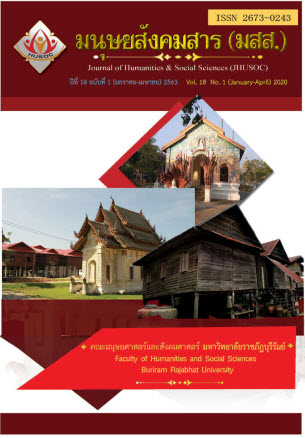An Investigation of EFL Students’Perspectives on Using Digital Storytelling to Enhance Self-Directed Learning: A Case Study of EFL Thai Learners
Main Article Content
บทคัดย่อ
This quasi-experimental study aimed at investigating the students’ perspectives on using digital storytelling for improving self-directed learning in EFL learners at Ubon Rachathani Rajabhat University. Data was collected via semi-structured interviews from nine students classified into three groups with different English ability levels; high, moderate and low, studying English for Communication and Work in the third semester of 2016, and was analysed through content analysis. The findings indicated that learning through digital storytelling could improve self-directed learning: self-planning, self-finding resource, self-control, and self-reflection. Thus, instructors should encourage this learning strategy during instruction and integrate the strategy in every field of education and life if they would like to increase their self-directed learning.
Article Details
เนื้อหาและข้อมูลในบทความที่ลงตีพิมพ์ในวารสารทดสอบระบบ ThaiJo2 ถือเป็นข้อคิดเห็นและความรับผิดชอบของผู้เขียนบทความโดยตรงซึ่งกองบรรณาธิการวารสาร ไม่จำเป็นต้องเห็นด้วย หรือร่วมรับผิดชอบใดๆ
บทความ ข้อมูล เนื้อหา รูปภาพ ฯลฯ ที่ได้รับการตีพิมพ์ในวารสารทดสอบระบบ ThaiJo2 ถือเป็นลิขสิทธิ์ของวารสารทดสอบระบบ ThaiJo2 หากบุคคลหรือหน่วยงานใดต้องการนำทั้งหมดหรือส่วนหนึ่งส่วนใดไปเผยแพร่ต่อหรือเพื่อกระทำการใดๆ จะต้องได้รับอนุญาตเป็นลายลักอักษรจากวารสารทดสอบระบบ ThaiJo2 ก่อนเท่านั้น
เอกสารอ้างอิง
Candy, PC., (2004). P.C. Candy Linking thinking: Self-directed learning in the digital age Department of
Education, Science and Training, Commonwealth of Australia.
Camargo, M., Bary,R.,Boly,V., Rees,M.,and Smith,R.(2011). Exploring the implications and impact of smartphones
on learning dynamics: The role of self-directed learning. Concurrent Enterprising (ICE), 2011 17th
International Conference On, IEEE. Retrieved on 1 July 2019 from
https://ieeexplore.ieee.org/document/6041267.
Chee T, Divaharan S, Lynde T, and Mun C. (2011). Self – Directed LEearning with ICT:Theory,Practice and
Assessment. Ministry of Education, Singapore. Retrieved on 1 July 2019 from
https://ictconnection.moe.edu.sg/
Churchill, N., Ping.LC& Oakleyet,L., Churchill, D. (2008). Digital storytelling and digital literacy learning.
Proceedings of International Conference on Information Communication Technologies in Education
(ICICTE).
Curwin, J. (2010). Using the principles of digital storytelling for student engagement and assessment.
Assessment, Teaching & Learning Journal 9: 16-18. Retrieved on 3 July 2019 from
https://eprints.leedsbeckett.ac.uk/
Dawson, S., Macfadyen, L., Risko, F,E., Foulsham, T., Kingstone,A.(2012) Using technology to encourage self-
directed learning: The Collaborative Lecture Annotation System (CLAS). Retrieved on 3 July 2019 from
https://repository.essex.ac.uk/
DeNatale, G., (2008). Videoed monologue storytelling Tips and resources. Retrieved on 10 July 2019 from
https://eds courses.ucsd.edu/eds204/su12/ELI08167B.pdf
Douglass, C.& Morris,R,S. (2014). Student perspectives on self-directed learning. Student perspectives on self-
directed learning. Journal of the Scholarship of Teaching and Learning, Vol. 14, No. 1, February 2014, pp. 13
-25. doi: 10.14434/josotl.v14i1.3202. Retrieved on 27 June 2019 from file:///C:/Users/Admin/Downloads/
El-Hussein, M.O.M. and Cronje,J.C. (2010). Defining Mobile Learning in the Higher Education Landscape.
Educational Technology & Society 13(3): 12-21. Retrieved on 25 June 2019 from
https://pdfs.semanticscholar.org/.
Gibbons, M (2002). The self-directed learning handbook: Challenging adolescent students to excel Jossey-Bass,
San Francisco (2002).
Hwang,J.G.,& Chang,H.F.(2011). A formative assessment-based mobile learning approach to improving the
learning attitudes and achievements of students. Computers & Education 56 (2011) 1023–1031. Retrieved on
June 2019 from https://compus.uom.gr/INF188/document/Arthra_gia_ergasies/
Jakes, D. (2006). Standards-proof your digital storytelling efforts. Tech &Learning. Retrieved from on 20 June
Jeng, Y.-L., Wu, T.-T., Huang, Y.-M., Tan, Q., & Yang, S. J. H. (2010). The Add-on Impact of Mobile Applications in
Learning Strategies: A Review Study. Educational Technology & Society, 13 (3), 3–11. Retrieved on 2 July 2019
from https://pdfs.semanticscholar.org/
Jenkins,M., and Lonsdale,J.(2007). Evaluating the effectiveness of digital storytelling for student reflection. Centre
for Active Learning University of Gloucestershire, UK. Retrieved on 27 June 2019 from
https://digitalstorylab.com/wp-content/uploads/2015/04/jenkins.pdf
Kim S. (2014). Development Autonomous Learning for Oral Proficiency Using Videoed monologue storytelling.
Language Learning & Technology. Volume 18, Number 2 pp. 20–35. Retrieved on 27 June 2019 from
https://llt.msu.edu/issues/june2014/action1.pdf
Knowles,M. (1975) M. Knowles. Self-directed learning: A guide for learners and teacher Cambridge, New York.
Lindgren,R.,and McDaniel,R.(2012). Transforming online learning through narrative and student agency.
Educational Technology & Society, 15 (4), 344–355. Retrieved on 27 June 2019 from
https://www.researchgate.net/publication/
Plews, R.C.,Kim, R., Olfman, L., Ryan, T. and Eryilmaz, E.(2014). Leveraging a personalized system to improve self-
directed learning in online educational environments. Computers & Education Volume 70, January 2014,
Pages 150-160. Retrieved on 20 June 2019 from https://www.sciencedirect.com/science/article/pii/
Roberson, D. & Merriam, S. (2012). The self-directed learning process of older, rural adults. Adult Education
Quarterly, Vol. 55 No. 4, August 2005 1-19. Retrieved on 23 June 2019 from https://www.academia.edu/
Sad, N, S. & Gokktas,O. (2014). Preservice teachers’ perceptions about using mobile phones and laptops in
education as mobile learning tools. British Journal of Educational Technology Vol 45 No 4 2014 606–618
doi:10.1111/bjet.12064. Retrieved on 22 June 2019 from file:///C:/Users/Admin/Downloads/
Sarica,GN & Cavus,N(2009). New trends in 21st Century English learning. ScienceDirect. Procedia Social and
Behavioral Science 1 (2009) (439-445). World Conference on Educational Science 2009. Retrieved on 27
June 2019 from https://cyberleninka.org/article/n/152866/viewer
Shahrebabaki,M. (2014). Using Self-assessment Checklists to Make English Language Learners Self-directed. Vol.
, Issue:6, Oct.-Nov. :2014 (IJRE) ISSN: (P) 2347-5412 ISSN: (O) 2320-091X. International Journal for Research
in Education (IJRE) (Impact Factor 1.5), ICV: 6.30. Retrieved on 27 June 2019 from
file:///C:/Users/Admin/Downloads/3_9-20-Masoud-Mahmoodi-Shahrebabaki.pdf
Timothy,T.,Chee,S,T.,Beng, C,L.,Sing,C,C., Ling,H,J,K.,Li,W,C.,Mun,H (2010). The self-directed learning with
technology scale (SDLTS) for young students: An initial development and validation. Computers & Education
(4): 1764-1771 Retrieved on 15 June 2019 from https://www.academia.edu/
Tullis,J.,G. and Benjamin,A.S.(2012). On the effectiveness of self-paced learning. Journal of memory and language,
– Elsevier. on 27 June 2019. Retrieved on 2 July 2019 from
https://www.ncbi.nlm.nih.gov/pmc/articles/
Valkanova, Y. and Watts,M. (2007). Digital story telling in a science classroom: reflective self‐learning (RSL) in
action. Early Child Development and Care Vol. 177, Nos 6 & 7, August 2007, pp. 793–807. Retrieved on 2 July
from https://citeseerx.ist.psu.edu/viewdoc/download?doi=10.1.1.631.9167&rep=rep1&type=pdf


